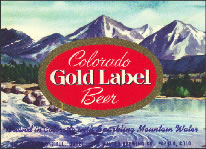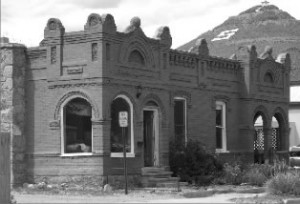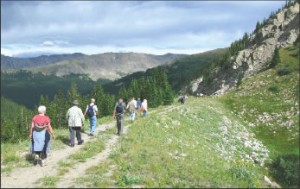(It’s Probably Coming To Leadville)
by Forrest Whitman
Every time I stroll along the out-of-service Union Pacific (U.P.) tracks near Cleora I get nostalgic for passenger trains. Why can’t I board a train in Salida? I know my black lab Gus and his buddy Bodie would hate to have trains honking along their favorite stretch of track and Bodie might just chase trains. But we could leave the dogs home and board in Leadville. That’s not a fantasy. Your Colorado rail authority is about ready to decide on a rail route through the Rocky Mountains. Mainly that’s to take the pressure off I-70, but it will serve Colorado Central Country, too. I’m predicting that a decade from now we’ll be able to board a “medium high-speed” electric MagLev train. That passenger train will whisk folks from Golden to the ski resorts, Leadville, and Eagle County Airport.
As I sit through board meetings of the rail authority I sometimes doze a bit and time travel. I can’t help thinking of how closely the main proposed route through the Rockies follows the dreams, schemes, and sometimes the actual rails of our Colorado railroad pioneers. That route ought to be named the Loveland, Gould, Pomeroy and Palmer (L.G.P.&P.) – a fitting tribute to their visions.
Mr. Loveland’s Route To The Casinos
One possible rail route chisels and grades its way up Clear Creek Canyon from Golden. That makes a good deal of sense if we consider that light rail will soon reach the municipal buildings in Golden. Soon we’ll have light rail service from D.I.A. to Golden where happy travelers will board our “L.G.P.&P. R.R.” Alas, Denver Union Station won’t be on the Denver portion of that route if the current plans of the Denver Union Station Project Authority go through (see the side bar). Starting in Golden (however we get there) we’ll travel up Clear Creek Canyon. As we do we can spare a thought for the “L” in our railroad, William A. H. Loveland. He pushed rails up that canyon and got to Black Hawk. His crews did it in only 17 months, arriving Dec. 15, 1872. His Colorado Central and Pacific Railroad was backed by Henry Teller (our first U.S. Senator) who’d just taken his law practice up to Central City. Teller convinced him that Gilpin was where the money and the freight and passenger income would be generated for a successful railroad.
Gilpin is a small county in part because there was so much wealth produced there at the time of statehood. Legislators didn’t think Gilpin County needed to be any bigger. That mineral wealth and the shipping it provided was a boon to Loveland and he was able to make enough money to push on to Georgetown in 1877 (though he didn’t reach Central City till 1878). When you consider that he built a rail right through the financial panic of 1873, it was quite an accomplishment. Today gamblers provide the wealth around Gilpin County. They could certainly board the new rail line, though they’d likely have to meet buses down at “Kermit’s Junction” for the last leg up along North Clear Creek (at least till a spur could be built). Tricky financing couldn’t stop William Loveland, but the Rocky Mountains did. He never got beyond Georgetown.
On Beyond Georgetown
Actually there were two railroads built in the 1870s beyond Georgetown. Jay Gould (the “G” in our L.G.P.&P.) was involved in the Georgetown, Breckenridge and Leadville. This is the route that built the famous Georgetown Loop which is such a tourist attraction today. Frank Maxwell, the engineer for the loop, took five years to lay track up and over itself to reach Silver Plume. That’s about as far as Jay Gould got with that line. Jay Gould had several other railroads in his Union Pacific pocket, so he wasn’t worried. But “Brick” Pomeroy (the first “P” in the L.G.P.&P.) had a better idea.
Brick edited the “Great Divide” a fairly short lived but still influential Denver newspaper. Brick was sure only a tunnel from Georgetown to a less steep grade beyond Silver Plume could ever accomplish what was needed. Whether Brick’s “Great Atlantic and Pacific Tunnel” was a legitimate enterprise or not, many invested in it. Brick probably took the money with him back to Brooklyn, New York. History seems to be on Brick’s side, though. Our modern rail line through the Rockies will have a nice long electrified tunnel accommodating an electric train from Georgetown to gentler grades beyond Silver Plume. European engineers assure us that these modern tunnels are safer than the old time bores. They’re equipped with escape routes, sprinklers and so on. Best of all is the electric aspect.
Gen. Palmer Gets Us Over
the Last Hump
We can’t get to Leadville without going over Loveland Pass. The modern rails are envisioned as going only part way up the pass until a tunnel, another fairly long one, pops us out on the other side so we can head down to Frisco. This is not an engineering feat like the Eisenhower Tunnel, however. Modern rail tunnels for electrified trains are fairly narrow and cut through hard rock. They are less an engineering “miracle” than the Eisenhower was. From Frisco we follow a fairly level route to the junction of I-70 and Colorado 91 by Copper Mountain ski area. From here up to Leadville the rails still exist, or at least the right of way does. Another tunnel possibility presents itself near Climax mine, but that’s still in the early planning stages. Readers of Colorado Central will be waiting in Leadville for the first train. From Leadville the rails go over Tennessee Pass with a stop at Ski Cooper. Vail (via Minturn) is our next stop on the way to the terminus at Eagle County Airport. Connections to Glenwood Springs via bus make possible a trip onward to San Francisco and the Golden State.
In Leadville I’d suggest we pause to honor the fourth of our railroad pioneers (the second “P” in L.G.P.&P. R.R.), General William J. Palmer. Palmer was no small-time dreamer. His Denver and Rio Grande was going from Denver to Mexico City by way of Leadville, Minturn, and then on south along the Colorado River with a sharp turn south to El Paso, and on to Mexico City. It was a big dream. Our modern railroad will follow Palmer’s route at least as far as Minturn.
There is a still more interesting dream out there for side routes from Leadville. We could push rails up past Twin Lakes and on to Aspen. Austrian and Italian engineers have done bigger grades. Since we’re dreaming, why not re-open the Alpine Tunnel? Though it sounds like the Steve Frazee novel, The Way Through the Mountains, it is possible. This track would run our fast trains up from the Arkansas River and down to Gunnison. That’s certainly the kind of dream that would have appealed to General Palmer.
Palmer did have one major problem – the Santa Fe Railroad. Palmer’s route south was blocked at Raton Pass by the Santa Fe. That’s why he decided to turn west up the Arkansas River to Leadville in the first place. Both the D & R.G. and the Santa Fe wanted to come up to Leadville from the flat lands at Canon City. There was an intense rivalry and even some shooting. Which railroad would get up to Leadville first? The “Royal Gorge Railroad War” needs at least another few pages to write, but suffice it to say the battle was eventually won by General Palmer.
The final skirmish occurred when the Santa Fe hired Bat Masterson and his band of thugs to “disable” the D. & R. G. crews. Masterson and his gang arrived in Pueblo in an armored train and things looked grim for Palmer. But free drinks, free women, and free farm hands were soon offered to Masterson’s troops. In a few days they were in no condition to fight. Palmer always said he didn’t know who was paying the bill, but the Denver papers said it was him. Eventually the courts ruled the D. & R. G. the rightful owners of the right of way up through Royal Gorge and on to Leadville. For his efforts, Palmer deserves at least some level of praise.
The Loveland, Gould, Pomeroy and Palmer Railroad Will Be Built
It is fun to be part of our railroad authority as the studies of a mountain railroad spin out in reams of paper and charts. The alternative to I-70 is clearly going to be rail. We keep hearing from Washington that money for passenger rail is headed down the track. MagLev electric train technology has certainly made mountain railroads possible in many other countries and such a train could run here. When we get to ride it someday why not remember those railroad pioneers who actually pushed some rails and dreamed some dreams up to our snow-capped peaks. Here’s to the L.G.P.&P.!
Forrest Whitman is a second-term county commissioner and serves on more state boards and committees than he can quickly remember, but he loves the rail board . He’s written for Colorado Central before and can be found at Bongo’s in Salida having coffee a couple mornings a week, or walking with Gus the lab and Ed Quillen (the guy Bodie takes care of).


